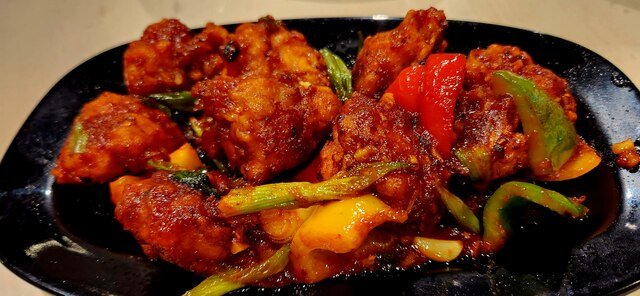n

n
How to make Inji Curry
n
n
Inji curry with roasted coconut is a delightful South Indian dish that tantalizes the taste buds with its unique blend of flavors and textures. This dish, also known as ginger curry or inji puli, is a traditional favorite in the cuisine of Kerala, a picturesque state in the southwestern part of India. In this recipe, we will embark on a culinary journey to unravel the secrets of this delectable dish, exploring its ingredients, preparation, and cultural significance.nnThe history of inji curry with coconut is intertwined with the rich culinary heritage of Kerala. Kerala's cuisine is renowned for its use of coconut, spices, and the meticulous combination of flavors. Ginger, a key ingredient in this dish, has been an integral part of Indian cuisine for centuries due to its medicinal and culinary properties.nnIngredients:
n
n
- n
-
Ginger: At the heart of inji curry is ginger, which imparts its pungent and slightly spicy flavor to the dish. Fresh ginger is preferred for its aromatic qualities.
-
Coconut: Coconut, in various forms, is the second crucial ingredient. Coconut slices provide the dish with its creamy texture and the quintessential Kerala taste.
-
Tamarind: Tamarind paste or pulp lends inji curry its tangy and slightly sour flavor. This sourness balances the heat from ginger and the sweetness of coconut.
-
Green Chilies: Fresh green chilies add a touch of spiciness to the dish. The quantity can be adjusted according to your heat tolerance.
-
Jaggery: Jaggery, a traditional Indian sweetener made from sugarcane juice or date palm sap, is used to balance the flavors by providing sweetness.
-
Mustard Seeds: Mustard seeds are a staple in South Indian cooking and are used for tempering to release their nutty flavor.
-
Curry Leaves: Fresh curry leaves are essential for the authentic flavor of Kerala cuisine. They add a unique aroma and taste to the dish.
-
Asafoetida: Asafoetida, also known as hing, is a pungent spice that enhances the overall flavor of the dish.nn
n
n
n
n
n
n
n
n
n
Preparation:
n
n
Inji curry with coconut is a combination of sweet, spicy, tangy, and savory flavors, and its preparation involves several steps:n
n
- n
-
Preparation of Ginger: Start by peeling and finely chopping or grating fresh ginger. The quantity of ginger can be adjusted according to your preference for spiciness.
-
Grated Coconut: Grate fresh coconut or use desiccated coconut to prepare the coconut base. Fresh coconut is preferred for its superior flavor.
-
Tamarind Extract: Soak tamarind in warm water and extract its juice. This juice will provide the dish with its characteristic tanginess.
-
Tempering: Heat oil in a pan and add mustard seeds. Once they splutter add curry leaves . The tempering process releases the aromatic oils from these ingredients.
-
Add Shallots : Add finely chopped shallots and green chillies
-
Adding Ginger: Add the fried ginger and coconut slices to the tempering and sauté it until it becomes aromatic and slightly golden.
-
Tamarind: Add the tamarind extract, which will infuse the dish with its sourness.
-
Jaggery: To balance the flavors, add jaggery to the pan. The jaggery will dissolve and provide a subtle sweetness to the curry.
-
Simmering: Allow the mixture to simmer on low heat until it thickens and the flavors meld together. Stir occasionally to prevent sticking.nnnInji curry with coconut is not just a dish; it is a reflection of Kerala's vibrant culture and its connection to nature. The use of locally sourced ingredients, such as ginger and coconut, showcases the state's agricultural abundance. Moreover, the meticulous combination of flavors in this dish represents the culinary artistry for which Kerala is renowned.nnBeyond its culinary significance, inji curry plays a role in Kerala's cultural traditions. It is a common fixture in festive meals, family gatherings, and religious ceremonies. The dish's unique blend of sweet, sour, and spicy flavors symbolizes the diversity and harmony in Kerala's culture.nnInji curry with coconut is a culinary masterpiece that embodies the essence of Kerala's cuisine. Its combination of ginger's fiery spiciness, coconut's creamy sweetness, and tamarind's tangy zing creates a symphony of flavors that is truly unforgettable. Whether enjoyed with rice, dosa, or any other accompaniment, this dish offers a glimpse into the rich culture and traditions of Kerala, making it a must-try for food enthusiasts and a testament to the culinary diversity of India. So, embark on this culinary journey and savor the magic of inji curry with coconut, one delectable spoonful at a time.n
n
n
n
n
n
n
n
n
n
n
Ingredients
n
- n
-
Ginger, finely chopped into round pieces – ¾ cup
-
Thinly chopped coconut slices – ½ cup
-
Shallots, finely chopped – ½ cup
-
Green chillies – 2, finely chopped
-
Turmeric powder – ½ teaspoon
-
Kashmiri chilli powder – 2 teaspoon
-
Coriander powder – 2 ½ teaspoon
-
Jaggery powder – 3 tablespoon
-
Tamarind – size of a small lemon
-
Curry leaves – 1 sprig
-
Mustard seeds – ½ Teaspoon
-
Fenugreek seeds – 1/4 teaspoon
-
Fenugreek powder – ½ Teaspoon
-
Asafoetida powder – a pinch
-
Sugar – 1 Teaspoon
-
Water – 3/4 cup
-
Coconut Oil – 3 Tablespoon
-
Salt to taste
n
n
n
n
n
n
n
n
n
n
n
n
n
n
n
n
n
n
n
n
Method of preparation
n
- n
-
Scrap the ginger and wash it thoroughly with most care as there are chances of mud on the surface of the ginger skin.
-
Once cleaned, finely chop the ginger pieces into small round shaped pieces. Keep it aside.
-
Chop the diced coconut into thin slices and keep them aside.
-
Soak the tamarind in 1/2 cup of water.
-
Heat oil in a frying pan and fry the ginger pieces. Once they are fried, remove from the pan.
-
In the same oil, fry the coconut slices. Roast till the color of the coconut slices becomes golden brown. Transfer the roasted coconut slices to another plate.
-
Grind the roasted coconut and fried ginger in a mixer along with 2 tablespoon of water.
-
In the same oil, splutter mustard seeds and fenugreek seeds.
-
Add finely chopped shallots, green chillies and curry leaves to the pan.
-
Once the shallot becomes golden in color, add turmeric powder, Kashmiri chilli powder and coriander powder.
-
When the raw smell of the powders are gone completely, add the ground paste of roasted coconut and fried ginger.
-
Then add tamarind pulp and jaggery to the pan
-
Allow the curry to simmer in low to medium flame.
-
Then add asafoetida powder, fenugreek powder, salt and sugar to the curry.
-
When the color of the curry turns dark and the consistency becomes creamy, remove from the fire.
-
Once cooled, transfer the curry to a small jar.
-
You can also refrigerate inji curry, make sure you use dry spoon to serve the curry.
n
n
n
n
n
n
n
n
n
n
n
n
n
n
n
n
n




